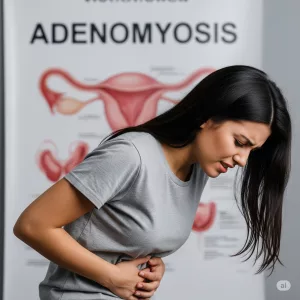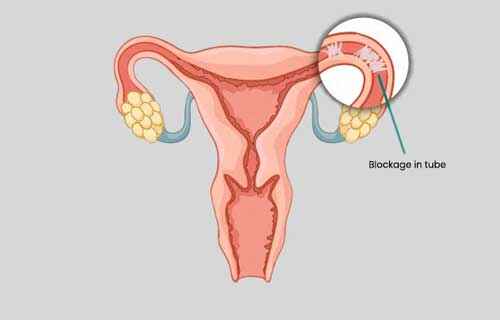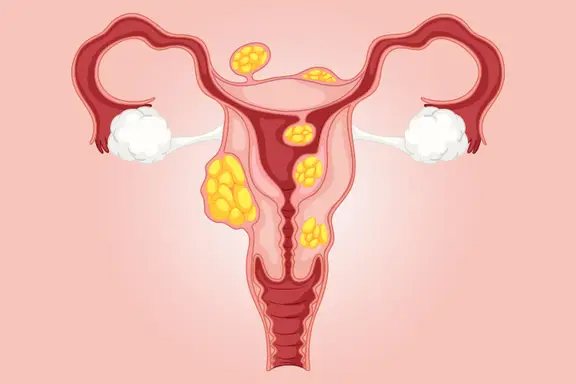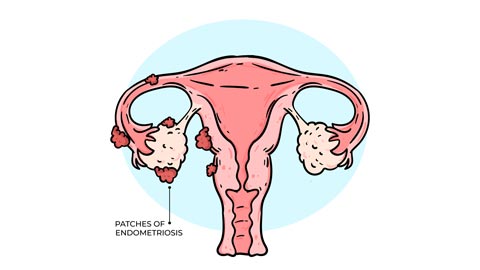
Yes Yoga can help heal Adenomyosis naturally by balancing hormones. Women with adenomyosis often experience heavy periods, severe cramps, and chronic pelvic pain. It’s commonly misdiagnosed or confused with endometriosis. Though the exact cause is unknown, hormonal imbalance and uterine inflammation are believed to contribute.
What is Adenomyosis
Adenomyosis is a condition where the inner lining of the uterus (endometrium) grows into the muscular wall of the uterus (myometrium). This can cause the uterus to become enlarged, thickened, and inflamed. It’s often confused with endometriosis (where the same tissue grows outside the uterus), but adenomyosis is its own condition, and it deserves its own care approach. Many women don’t get a clear diagnosis for years, which can make it feel even more isolating.
Differences between Endometriosis and Adenomyosis
| Aspect | Adenomyosis | Endometriosis |
| Location | Endometrial tissue grows into the muscular wall of uterus | Endometrial-like tissue grows outside the uterus |
| Uterus size | Uterus often becomes enlarged or bulky | Uterus usually remains normal in size |
| Pain type | More associated with heavy bleeding and cramping | More associated with pelvic pain, especially during sex or bowel movements |
| Fertility impact | May cause issues, but less common than in endometriosis | Frequently linked to infertility |
| Diagnosis | Often diagnosed via MRI or after hysterectomy | Can be diagnosed with laparoscopy |
| Treatment approach | Focus on managing bleeding and uterine inflammation | Focus on removing external lesions and managing hormonal balance |
In short:
Adenomyosis affects the muscle wall of the uterus, while endometriosis affects areas outside the uterus—but both involve abnormal growth of endometrial tissue and can lead to pain, hormonal imbalance, and
Why Does Adenomyosis Happen?
- Hormonal imbalances, especially high levels of estrogen, seem to play a major role.
- Inflammation in the uterus and immune dysfunction may also be involved.
- Women who’ve had childbirth, cesarean sections, or uterine surgeries may be more likely to develop it.
- And then there’s the quiet burden of chronic stress and trauma which may not show up on a scan, but can deeply impact the womb over time.
Whatever the cause, please know: it’s not your fault. Your body isn’t betraying you it’s signaling that it needs care.
Our Fertility Yoga Course for Adenomyosis:

Symptoms of Adenomyosis
Here’s what many women with adenomyosis report experiencing:
- Heavy and prolonged periods that leave you exhausted
- Crippling menstrual cramps, often worse than “normal” pain
- Chronic pelvic pressure or bloating in the lower belly
- Pain during intimacy
- Unexplained fatigue or brain fog, especially around your cycle
- Emotional overwhelm, mood swings, or anxiety before and during menstruation
If this sounds familiar, you are not being dramatic. You are not weak. You are likely dealing with something very realand very under-recognized.
Emotional Weight of Adenomyosis
Beyond the physical pain, adenomyosis can bring a deep emotional toll. The kind that doesn’t show up on blood tests or MRIs.
You may feel frustrated when you’re told everything is “normal.”
You may feel disconnected from your own body resentful of its unpredictability.
You may even feel grief: over missed days, lost energy, or the feeling that your womb is at war with you.
At Yog4Lyf, we want to hold space for that too. Healing isn’t just about fixing symptoms. It’s about rebuilding your relationship with your body with softness, patience, and trust.
Yoga Asanas to Naturally heal Adenomyosis
The right kind of yoga doesn’t push the body, it listens to it. These gentle, restorative poses are designed to support blood flow, reduce inflammation, and help your womb feel safe again.
Ustrasana (Camel Pose)
A nurturing pose that strenghthens the vertebral column and pelvic region . Perfect for bringing agility and blood circulation in the body.
Setu Bandhasana (Bridge Pose)
Strengthens the pelvic floor and encourages healthy circulation in the reproductive area. Can be done with support under the sacrum to reduce strain.
Viparita Karani (Legs Up the Wall)
A deeply calming pose that supports lymphatic drainage, eases bloating, and grounds your nervous system.
Balasana (Child’s Pose)
Soothes lower back pain and encourages emotional release. Rest your forehead on the mat or a block, and just breathe.
Malasana (Yogi Squat)
Opens up the pelvic floor and hips, relieving congestion in the lower abdomen. Use a rolled blanket under your heels if needed.These aren’t just exercises—they’re invitations to come home to your body.
Breathwork ( Pranayama ) for Adenomyosis
When pain builds in the body, it often brings mental restlessness and emotional fatigue along with it. Breathwork (pranayama) and mindful stillness can help quiet that noise.
Anulom Vilom (Alternate Nostril Breathing)
Balances both sides of the brain and body, calms the mind, and reduces hormonal fluctuations.
Bhramari (Bee Breath)
Gentle humming vibrations soothe the nervous system and can even reduce pain perception.
Yoga Nidra (Yogic Sleep)
Yoga Nidra guided deep relaxation practice that allows the body to rest, repair, and reset.
Sacral Chakra Meditation
Focuses on the energy center associated with the reproductive system like ovaries, fallopian tubes, uterus etc. Visualize warm orange light healing and nourishing your womb space.
Breath is powerful medicine. When done with intention, it becomes a form of self-love.
Small Lifestyle Changes to Support Your Practice
Pairing yoga with small, sustainable changes can help amplify your body’s healing:

- Eat an anti-inflammatory diet: Leafy greens, healthy fats, turmeric, ginger, and flaxseeds.
- Drink warm herbal teas: Fennel, chamomile, and ginger are soothing to the uterus.
- Avoid cold, processed, and estrogen-dominant foods.
- Gently massage your lower belly with warm castor oil.
- Prioritize rest and deep, uninterrupted sleep.
- Replace self-criticism with self-compassion.
Healing adenomyosis isn’t just about doing more, it’s often about doing less, and doing it with love.
You Are Not Alone
At Yog4Lyf, we’ve heard so many women whisper the same quiet questions:
“Is this all in my head?”
“Will I always feel this way?”
“Is there a way to heal without more pills and surgeries?”
Our answer is: Yes, there is a way. And you’re already walking it.
Yoga isn’t a quick fix, it’s a way of living, of relating to your body with presence and patience.
And when practiced consistently, with the right guidance, it can help you feel more like yourself again.
Ready to Begin Your Healing Journey?
If you’ve been silently struggling with adenomyosis, it’s time to stop walking this path alone.
We invite you to join our Yog4Lyf Yoga for Fertility Issues related Program a gentle, womb-supportive approach designed with empathy, natural science, and feminine care.
Begin with a breath.
Move with softness.
Heal with trust.
Because your womb deserves peace, so do you!
A Yog4Lyf’s Holistic Approach via :- Yog4Lyf App
In our app you will get
Live Classes: Morning and evening sessions for all fitness levels.
Diet Plans: Nutrition guides to complement yoga practice.
Community Support: Forums to share experiences and victories.









